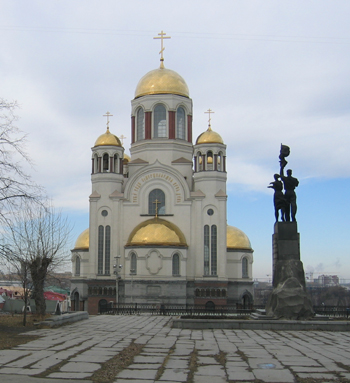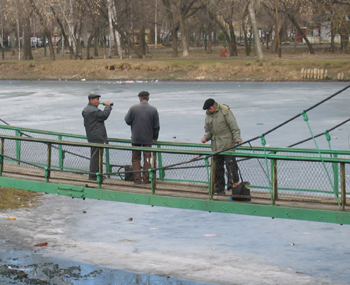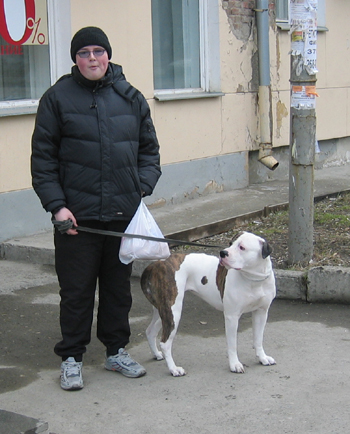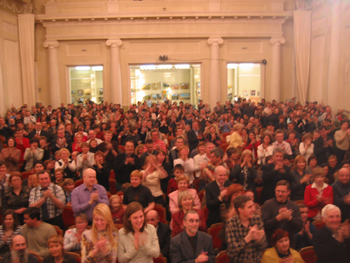Yekaterinburg
The Engineer throttles back, and the
huge electric motor, which has
driven and strained and carried us
all across the underbelly of Russia,
finally relaxes. The Trans-Siberian
slows to a crawl and enters the
station at Yekaterinburg.
As always there are several strong
men from the local Philharmonic Hall
jumping up and down the train stairs
to handle our luggage. We come to
street level in Yekaterinburg. At
1.3 million, it is Russia’s 5th
largest. Its growth is coming on
strong, and it’s quite a city.
Yekaterinburg is most famous because
at a church about a block from our
hotel, Czar Nicholas Romanov II and
his family were shot in 1918. That
whole business is filled with
intrigue, with the legend running on
and on that the youngest daughter,
with the magical name Anastasia, had
escaped.
Only now after all the years it is
known that all were killed. The
remains have been ceremonially
buried with deep reverence at the
Cathedral at St. Petersburg
alongside all the predecessors of
Nicholas II dating back to Peter the
Great.
It’s easy to pick out the Czarist
buildings; some of them are in good
shape or have been restored, and
some are in decay. Then there is the
communist stuff, looking bland and
kind of crummy, a lot like the worst
American public housing. But then
there are the “new Russian”
buildings, and generally these are
fine-looking at top-of-the-world
standards.
The musicians go on the prowl and
take some excellent photos. My
favorite is this one of three
fishermen on a bridge, one of them
swigging from a bottle.
Another is of a boy and his
beautiful dog. When I see a dog like
this it makes me miss my old dog
Peggy. I am like Mr. Bojangles—after
20 years still grieving for his dog.
All the Russian cities have
streetcars. This is especially
pleasing to me. The world seems
slowly coming in my direction on
this.
I remember how great they were in
New Orleans when I was a boy. Get on
for a nickel on Canal Street and
they would fan out through the
neighborhoods. In the late 1950s
they took them out, tore up the
rails and replaced them with
fume-spewing buses.
“Whose great idea was that?” we all
asked each other, and 45 years later
they put the streetcars back.
I admired Paul Crawford, the great
New Orleans trombonist. “People love
the romance of the streetcars,” he
said. “There’s no pollution and
they’re cheaper. It’s a
no-brainer.”
Anyway, they are now reappearing in
a number of American cities.
Our Sunday night concert at
Yekaterinburg is sold to the walls,
and 60 extra chairs have been put in
the entrance foyer. The elegant
Philharmonic Hall will seat 740. The
locals are serious about their music
and their concerts. They hold nearly
200 of them annually at this hall.
Their reaction to us is the same as
the other Russian audiences. The
applause runs on and on. There is an
immediate standing ovation at the
end. Some of the guys are saying
that maybe this is the best so far.
I don’t know. They are all beginning
to blur together in my memory.
The trumpet player from the jazz
club in Ufa, the one I condemned as
“over-amplified” is there. He has
traveled 400 miles to attend the
concert and is very complimentary.
We struggle with the language
barrier. Finally, he tells Valeri
that he is impressed the most by our
band’s playing together while he is
accustomed to playing against the
other musicians, each trying to
display more virtuosity. And he is
amazed by the non-amplified sound.
I am flattered by his comments. He
is quite a virtuoso himself and
brings a lot of creativity to his
be-bop.
The band is shown into the large,
elegant private office of the
Director of the Philharmonic where a
formal dining table awaits. The
Director is vibrant, welcoming, and
extra friendly. He greets us with an
almost steady stream of Russian and
Russian vodka. We join in the
salutes. A Salute to music, to the
Philharmonic, to the hall, to our
band, to all women, to friendship. I
stand and salute the Russian People
and the Russian Nation.
Finally, Valeri offers the most
eloquent toast to the Philharmonic
Society, its Director, President and
Deputy (also on hand) and how they
have supported the Arts like no
others. He says he means it, too.
Down the hatch with the vodka, and
then there’s a “military toast”
where we all stand with arms folded
in front of us while the Director
holds his vodka glass on his right
elbow and somehow downs it without
spilling it or dropping the glass.
After each shot he pauses, then
gesturing with clenched fist he lets
out a loud “Da!” Clearly, however,
he is highly intelligent and
capable. I see no sign of
intoxication as he articulates, now
with Valeri interpreting, the
history of the Yekaterinburg
Philharmonic Orchestra and why it is
the best in all of Russia. He has
been involved with the Chicago
Symphony, studying their
organizational techniques, and
famous orchestras in Europe too, and
feels he has combined the best of
American and European management and
fundraising.
The Yekaterinburg orchestra and its
quality was until 1994 quite a
secret from the outside world, for
the city was the center for all the
Soviet high military technology. As
a result, citizens from the area
were not allowed to travel abroad,
period. Foreigners could not visit
Yekaterinburg.
All during these festivities, great
food and wine is being served. It’s
the most fun I’ve had in Russia
except for being onstage.
Earlier that day I was picked up by
Svetlana, a translator, and we went
to a local FM radio station where a
crusty old radio cat interviewed me
at length—an hour and 45 minutes of
length. He had read many books on
jazz by Leonard Feather, James
Lincoln Collier and others.
He asks a number of questions,
eventually working around to asking
some about the differences between
white and black jazz musicians. I
give sincere, honest answers that
the differences tend to be
individual, not racial, etc.
He says, “But Mr. James Lincoln
Collier says there are clear racial
differences and he’s an expert. Do
you mean to challenge the opinion of
Mr. James Lincoln Collier, the
expert?”
“I guess so.”
“Very interesting,” he says. “And
you, the leader of the most famous
Dixieland band in the world, must
know something about this, too.” He
looks very serious and then he adds,
“But Mr. James Lincoln Collier?”
“I don’t know,” I say, “Why don’t we
talk about Louis Armstrong or
something?”
There was a long pause. Finally, he
says, “Very good,” and we go in
another direction. He asks me what I
thought of teaching jazz in
conservatories. I respond that I
think it is not impossible to teach
jazz in conservatories but it is
difficult, because I think jazz is
best learned sitting at the feet of
a great master—that it is easy to
teach formulas at conservatories but
creativity has to be found by one’s
self, through the example of a
creative and inspired master.
Boy, he really likes that. There’s a
pause while he hears the translation
from Svetlana. He lights up, reaches
over and begins shaking my hand
vigorously up and down for a long
time. What a kick!
I walk outside, and in the hallway
they’re preparing vodka toasts.
Having eaten nothing all day, I am
not at all ready for a shot of
vodka. They insist and insist.
Finally I fall back to “I’m sorry, I
am an alcoholic,” (which is not
true) and this stops them.
“I am so sorry,” one of them says.
“Oh, no,” I say, “Don’t let me stop
you, Please, let’s have a toast.”
The interviewer was trying to stop
smoking and he had pieces of hard
candy, a couple of which he had
given to me. I pull out one of them
from my shirt pocket and make a
toast with it. “To our friendship
and the great Russian Nation.” I
raise my piece of candy as they all
raise glasses of vodka, which are
all tossed off with broad smiles and
laughs and handshakes. I think I get
away with it.
They follow me to the car still
talking on and on about the genius
Beiderbecke and then about
Ellington—Svetlana translating like
crazy.
I’ll tell you, when you’ve got a
jazz nut, they are the same
everywhere in the world. We part in
the center of Yekaterinburg on the
big, open stone-paved square, with
the classic buildings all around—the
streetcars running down one side. We
embrace, almost certain never to
meet again. I told them of my
teacher Carlton MacBeth and the
parting he and I always used: “We
have the same feathers!”
Svetlana works pretty hard at that
translation, but finally they
understand.






